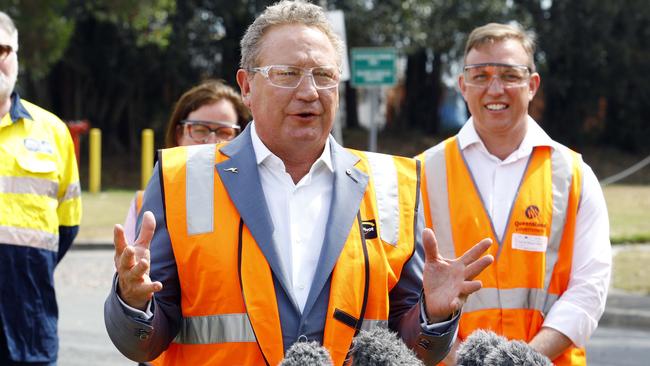Fortescue will partner with Incitec Pivot to study viability of green ammonia
Fortescue investors could get external validation of hydrogen plans through a commercial study with ammonia major Incitec Pivot.

Business
Don't miss out on the headlines from Business. Followed categories will be added to My News.
Fortescue Metals Group faces the first major commercial test of its plans to expand into hydrogen, with the company to partner with Incitec Pivot to examine the production of green ammonia at Incitec’s Gibson Island plant in Brisbane.
The feasibility study is due to report by the end of the year, in a move believed to be the first time Fortescue Future Industries (FFI) has partnered with another major corporation to examine the commercial viability of its hydrogen technology and production plans.
Gibson Island currently uses natural gas to produce about 550,000 tonnes of fertilisers a year, and the feasibility will examine whether the construction of a 50,000 tonne a year hydrogen plant, powered by renewable energy, could eventually displace gas in the production of about 300,000 tonnes of ammonia each year.
Fortescue founder Andrew Forrest told reporters in Brisbane that a full scale hydrogen facility at Gibson Island could cost up to $400m, with the decision on whether it will be built dependent on the results of the feasibility study.
The potential use of hydrogen at the plant could be a key to its continued future, with high gas prices one of the major issues for the ageing plant’s commercial viability.
Gibson Island’s current gas contract runs out at the end of 2022, with Incitec looking to open tenders for a replacement long-term contract by the end of this year.
The previous deal was signed in 2019 after the Queensland government came to the plant’s rescue, and current global gas prices are likely to again pose a major threat to Gibson Island’s ongoing viability.
Incitec managing director Jeanne Johns told The Australian the company was already talking to gas producers about a replacement contract, saying the company was “currently in discussions with gas producers on securing gas at an internationally competitive price for Gibson Island beyond 2022”.
But, speaking in Brisbane on Monday, Ms Johns said she hoped the study with FFI would show that the use of hydrogen would eventually replace natural gas and lower the cost of ammonia production at Gibson Island, helping secure the long-term future of its plant and the 400 workers it employs.
“Here at Gibson island we have an existing facility, its infrastructure and its highly skilled workforce that can be put to this use. We believe that not only will that lower the cost of production here, but also, most importantly, the path and the speed to market,” she told reporters on Monday.

The Incitec partnership follows Mr Forrest’s announcement on Sunday that FFI will build a $US650m ($887m) factory in Gladstone to manufacture electrolysers needed to convert water to hydrogen.
Fortescue said on Sunday its initial investment in the project would be about $US83m, with construction planned to start in early 2022.
The company said it planned the Gladstone plant will eventually become a broader manufacturing centre feeding FFI’s plans to produce 15 million tonnes of renewable hydrogen each year, with the company saying it was drawing up plans for the facility to eventually manufacture “wind turbines, solar photovoltaic cells, electrolysers, long-range electric cabling, electrification systems and associated infrastructure.”
But while Mr Forrest continues his march towards recasting the iron ore giant as a global energy company, analysts on Monday expressed further concerns about lack of detail on the projects being given by the company.
Fortescue has previously said it plans to spend about 10 per cent of its net profits on pursuing its green energy goals, with $US400m to $US600m likely to be spent in the current financial year.
RBC analysts said in a client note on Monday they still believed that, even assuming FFI could steeply reduce production costs of green hydrogen and ammonia from levels currently achievable, they still believed the economics of its production would still “fall short of providing an adequate return and struggles to be competitive with brown ammonia”.
“Similar to previous FFI renewable energy announcements the project economics, financial metrics and details are light (on scope, scale, costs, capex, timing),” RBC analyst Kaan Peker said in a client note on Monday.
“The investment could be up to $US650m. The initial electrolyser investment is expected to be US$83m. It is unclear what is defined by “initial electrolyser investment,” and what is included in the total “investment” of up to US$650m, but capital intensity seems very low.”
Fortescue shares closed up 75c, or 5.3 per cent, to $15 on Monday.





